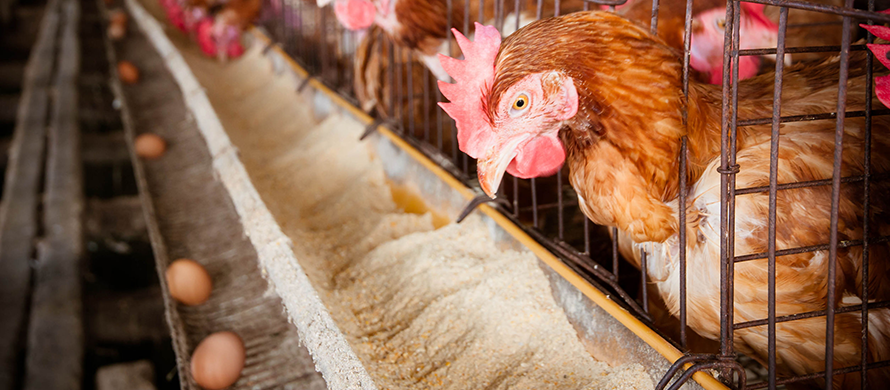Codex experts discuss risks of contamination in feed from carryover
More than 350 participants gathered online on Thursday 25 March 2021 to learn more about the risks of contamination of animal food and feed from carryover – a process of feed contamination that can occur during feed processing, handling, transportation, delivery or in feeding animals on-farm, when residues of veterinary drugs are unintentionally transferred to a food-producing animal.
The meeting was an opportunity to discuss the publication of an FAO/WHO expert meeting report entitled Carryover in feed and transfer from feed to food of unavoidable and unintended residues of approved veterinary drugs.
The introduction to the publication explains that the risk of feed carryover is acceptable in situations where there is no negative impact on animal or human health, but not for drug carryover that causes adverse health effects in either the animals or in humans consuming foods originating from these animals.
“If carryover is not properly managed, contaminated feed can directly harm species that are sensitive to the unintended veterinary drug they consume, and can result in residues in food of animal origin such as meat, milk and eggs that might render them unsafe for human consumption,” said Vittorio Fattori, FAO. Even if residues are not a safety hazard, they can pose regulatory and global trade issue as countries/markets may enforce a “zero” tolerance for residues when appropriate maximum residue limits have not been established.
Kevin Greenlees, Chairperson of the Codex Committee on Residues of Veterinary Drugs in Food (CCRVDF), from the United States, told participants that the work leading to the publication was undertaken at the request of CCRVDF and as this issue was on the agenda of the upcoming session. He encouraged participants to use this opportunity to gain further insight into the topic to facilitate discussions at the next session of the committee.
Presenting the outcome of the expert meeting, Daniela Battaglia, FAO said, “specific risk assessments may be required to determine if the level of carryover results in food residues that exceed health based guidance values such as acceptable daily intakes and that might also need to consider if residues at carryover concentrations in animal feed present a risk of AMR”.
Case studies from Australia and Canada illustrated the reality of this issue and how the two respective national authorities had addressed the problem. James Deller from the Australian Pesticides and Veterinary Medicines Authority described how, when following the detection of nicarbazin in eggs through their residue monitoring programme, traceback investigations had confirmed that egg producers were not intentionally treating their laying chickens with nicarbazin-medicated feed. While the feed mills were complying with the principles of good manufacturing practice and employing practices to reduce the likelihood of nicarbazin occurring in un-medicated feed, investigations confirmed that the feed mills from which the egg producers were sourcing their feed also produced medicated feed and unintended carryover to the un-medicated feed was the likely source of the problem. “As a result, for the first time we established an MRL [maximum residue limit] to cover residues that may occur in food as a result of carryover,” explained Deller.
When Canada faced a similar problem with ionophores in eggs, Health Canada undertook a risk assessment. David Johnson of the Canadian Food Inspection Agency (CFIA) said, “CFIA responded by developing methodologies to detect low levels of residues, and risk based maximum levels for unintentional carryover for feed and food”. CFIA also developed a guide to help the feed industry manage the order of production of medicated feed and non-medicated feed to limit carryover residues to feed for species where low-level residues would not result in a food violation
“Producers, handlers and all those involved in feed have a huge experience in this area,” according to Battaglia and a stakeholder meeting that took place in advance of the expert FAO/WHO meeting helped ensure that the experts had as much information as possible on the issue, including the challenges faced and measures already in place to address the problem of unintended or unavoidable carryover of residues.
Gracia Brisco of the Codex Secretariat said: “This type of technical webinar, bringing together animal feed experts and those involved with veterinary drugs and setting standards in Codex, ensures we reach many countries who will rely on this information when working to strengthen national capacities for implementation of texts such as the Codex Code of Practice on Good Animal Feeding. Countries will also need to prepare to consider the outcomes of the FAO/WHO Expert Meeting at the forthcoming CCRVDF to determine follow-up actions to address this issue”.
Read more
Photo credit
© 123RF
Categories
- (11)
- (19)
- (15)
- (3)
- Animal Feed (8)
- Antimicrobial Resistance (47)
- Antimicrobial Resistance (88)
- CAC47 (10)
- Codex Texts (18)
- Codex Trust Fund (3)
- Contaminants (13)
- Contaminants (10)
- COVID-19 (64)
- Elections (6)
- Food Safety (132)
- Labelling (13)
- Monitoring (10)
- Nutrition and Labelling (6)
- Nutrition and Labelling (7)
- Observers (27)
- Pesticides (9)
- Standards (82)
- World Food Safety Day (165)



